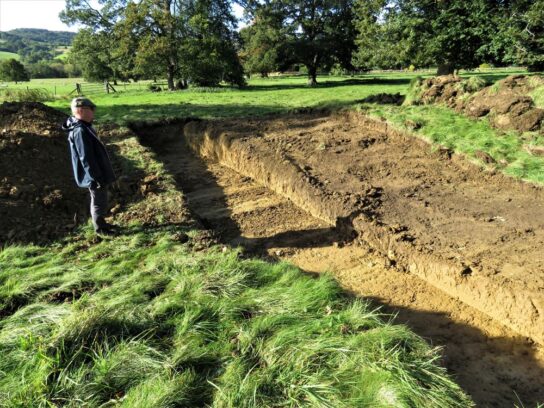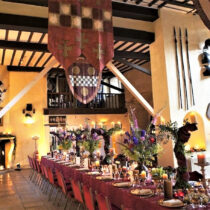
Recall from my column last month that in October 2021 I participated in an archaeological dig at Sudeley Castle in Gloucestershire, searching for the missing Banqueting Hall of Queen Elizabeth I, and also her missing Tudor Garden. So, did we find them?
Our team found the Tudor Garden – although fully documenting it will take more work. The very formal layout has been largely confirmed by LiDaR (light detection and ranging) and trenching, with formal beds and mazes near the main castle, further garden beds extending outwards, a circular walkway, an inner bank, and a centerpiece circular water feature, likely a fountain fed by a well. The Garden appears to have been built in two phases, the first in the 1540s, with an extension in the 1570s. The overall Tudor Garden size is astounding, perhaps 500 by 500 yards.
Later the Tudor Garden was covered up with a substantial layer of earth, probably when such formal gardens fell out of favor. In this third phase, a huge, naturalistic landscape garden was built, with undulating small hills, rolled grass, and serpentine ponds with walkways and bridges.
The cost of the garden was incredible – each of the three building phases would likely cost at least ten million dollars today.
Historical research undertaken during the dig revealed that the term “banqueting” in Elizabethan times referred to what we would today call eating the dessert course in an elaborate meal. “Banqueting” in this instance meant that the host and his staff would go into the Tudor Garden, shortly before the meal, coat the flowers with gum water, then sprinkle the flowers with sugar — very expensive at the time. So for the dessert/”banqueting” course, the guests would walk around the garden, and find and eat the live, sugar-coated flowers!
And the missing Banqueting Hall? Well, that is a definite maybe. The team found a very substantial dry-stone wall, almost a meter wide, with massive, deep footings. At first we thought this was the foundation of the semi-temporary (but substantial) Hall. But as digging and probing revealed more and more wall – more than 30 meters and counting – it became likely that this was the substantial back wall of the Tudor Garden, covered up by the later third phase of garden construction.
The picture was clouded by finding numerous sandstone roof tiles, and stone Tudor Rose and other decorations – I think that indicates a substantial, more permanent Banqueting Hall. But the expert archaeologists on the team felt that all that material was more likely just fill from phase three of construction, brought in from the nearby, ruined Winchcombe Abbey to build up the landscape and cover the Tudor Garden. So, it looks like more searching for the Banqueting Hall is needed in 2022.
If you want to participate in the search, for a day, several days, or a week, check out the non-profit DigVentures.com. Signups opened on December 1, 2021, and places go very fast, as Brits are “mad keen” on archaeology!
Photos courtesy Lew Toulmin
- A. Closeup of a temporary Banqueting Hall built for Henry VIII for the 1520 Field of the Cloth of Gold event near Calais, France. The “castle” is actually a tent built on a brick foundation, with canvas walls and roof. The two fountains in front of the tent/structure spouted wine and beer for public consumption – and drunkenness.
- B. A young girl dig volunteer holds up a pistol ball she found – likely fired when Sudeley Castle was besieged during the English Civil War of 1642-1651.
- Coat of arms of the Barons Chandos, who owned Sudeley Castle during the Tudor period, and erected the temporary Banqueting Hall – now missing – to impress and entertain Queen Elizabeth I.
- D. Author Lew Toulmin at the main 2021 excavation trench at Sudeley, holding the flag of The Explorers Club (explorers.org). Club members were first to the North and South Poles, to the top of Mt. Everest, to the bottom of the deepest ocean trench, and to the Moon. There are 220 Club flags, and members may apply to carry one on a suitable effort.
- E. A secondary trench cut during 2021 at Sudeley yielded no artifacts or structures. But careful analysis of the stratigraphy of the earth revealed that massive amounts of new soil were brought in by wagons and carts to create new paths, mounds and serpentine ponds.
- F. A LiDaR study of the area shows the Castle outlined in black on the left, with the Tudor Garden in the square on the right. The Garden is invisible on the ground to the naked eye, but many features show up on the LiDaR image, which was taken from a drone overhead.
- G. A major stone wall and foundation appeared at first to be the missing Banqueting Hall, but later analysis leaned towards this being the foundation of a substantial back wall to the Tudor Garden. More searching to do in 2022!
- H. Sandstone roof tiles found near the wall are puzzling – are they from the missing Banqueting Hall, or are they just land fill? And why use weak, porous sandstone for roof tiles, anyway? Hey, if this stuff was easy, they wouldn’t have called in the Pros from Dover!











Comments are closed.